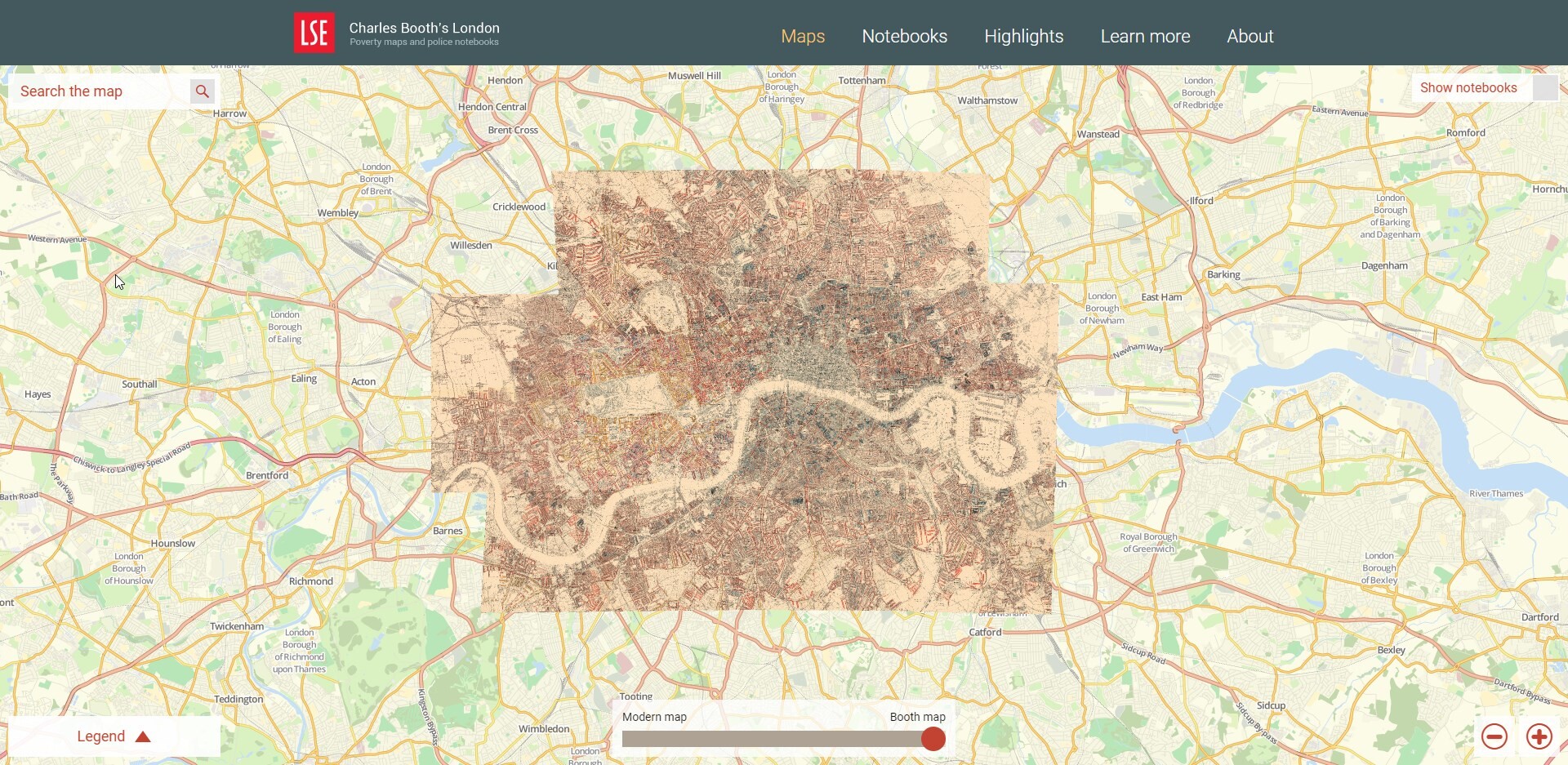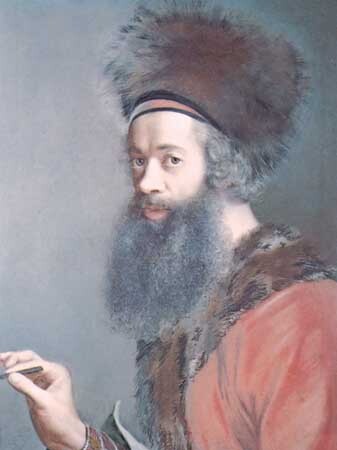Ellida Minelli's Top Picks - Art and Maps - July 24, 2023
Step 0 of 0
1

2

3

4

5

6

7

View of Venice, aka the de' Barbari Map - 1500
View of Venice, also known as the de' Barbari Map, is a monumental woodcut print showing a bird's-eye view of the city of Venice from the southwest. It bears the title and date "VENETIE MD" ("Venice 1500"). It was printed from six wooden blocks designed from 1498 to 1500 by Jacopo de' Barbari, and then published in late 1500 by the Nuremberg publisher Anton Kolb on six large sheets of paper, each measuring about 66 cm × 99 cm (26 in × 39 in), to create a composite image measuring approximately 135 cm × 280 cm (53 in × 110 in). The individual sheets of paper were the largest produced in Europe up to that time. Source: Wikipedia
Descriptive Map of London Poverty - Charles Booth - 1889
Charles Booth's London Poverty Maps were a significant contribution to understanding the social and economic conditions in Victorian London. Here is a brief history of Charles Booth's London Poverty Maps:
- Funding and Survey: Charles Booth, a Liverpool ship owner, funded the creation of the poverty maps. He conducted a survey of the population between 1886 and 1903 to gather data on the living conditions and poverty levels in London
- Mapping Method: The poverty maps were color-coded maps that visually represented the different levels of poverty in London. They covered an extensive area, from Hammersmith in the west to Greenwich in the east, and from Hampstead in the north to Kennington in the south
- Publication: The first edition of Charles Booth's London Poverty Map was published in 1889-1890, and a revised edition was published in 1898. The maps were accompanied by detailed descriptions and analysis of the poverty levels in different areas of London
- Impact and Relevance: Charles Booth's poverty maps were groundbreaking at the time and provided a comprehensive understanding of the social and economic conditions in Victorian London. They highlighted the stark disparities between wealthy and impoverished areas of the city. The maps continue to be relevant today as historical documents that shed light on the living conditions of the time
Overall, Charles Booth's London Poverty Maps were a pioneering effort to document and understand poverty in Victorian London. They remain valuable resources for historians and researchers studying the social and economic history of the city. 5321.
Source: perplexity.ai, DavidRumsey.com,
Download the maps here from LSE.
https://www.layersoflondon.org/map/overlays/charles-booth-s-poverty-map-1886-1903

Room of Maps, Villa Farnese - Giovanni Antonio da Varese - 1574
Giovanni Antonio da Varese , known as the Venosino (that is to say the artist of Venosa 1 ), is an Italian painter of the 16th century . He is best known for the world maps he painted, first in 1574 in the Room of the World Map of the Villa Farnese in Caprarola , then, at the request of Pope Gregory XIII , in the Vatican , in the Terza Loggia 2 . Source: wikipedia
-image-desc.jpg)
Source: Artsy1 and Artsy2
A map that Tricia Sellman found in a fashion advertisement, which triggered some research and exploration. September 2020. Details here and below.
Link Cucinelli website and ad:
- https://www.brunellocucinelli.com/en/campaign-fw20.html
- “From here on, I would like to resume the journey towards Universal Humanism"
- Universal humanism refers us to the whole of human existence, respects every dimension of our life, and looks for such interpretation in which even the most fragile aspects of human existence find their meaning. Source
Location of map:
- Villa Farnese, Caprarola, Italy (50km north of Rome)
- Wikipedia on Villa Farnese
Commentary on Villa Farnese and its art/maps:
- wikipedia
- Ilturista.info - need to translate the page
- Jstor
On Varese the map-maker:
Sources of images:
- 123RF
- Getty Images
- Mapporn
- 360 view of Hall of Maps (check this out!)
Other work by Varese:
- In the Vatican, Terza Loggia
Other important buildings from the Farnese family:
keyword: various
The Tailor, Moroni - 1570
"The Tailor" (Il sarto) is a 16th-century portrait painted by Giovanni Battista Moroni1. The painting depicts a member of the Fenaroli family, who is represented as a tailor practicing his art during the workday1. Portraits of important persons and personages of Italy, including merchants, aristocrats, and nobles, were the representational specialty of the artist Giovanni Battista Moroni1. The Tailor is unusual in Renaissance portraiture for its presentation of a man performing his trade2. The painting is one of Moroni's most famous portraits and is considered an astonishing work of art3.In 2008, The Tailor was displayed in the Museo del Prado, Madrid, in an exposition of Renaissance-era portraits, and it is currently at the National Gallery of London, in the United Kingdom1. The painting is notable for the fact that Moroni gives the tailor the same nobility of pose and countenance as his aristocratic clients4. The tailor is using his scissors to cut a piece of black cloth, and he wears a red codpiece between his bulging pantaloons4. Moroni may or may not be depicting a real tailor, but he is also portraying himself in the painting4. The tailor is seen as an artist, and the painting is considered a rebellion against the traditional portrayal of artisans4.Moroni's tailor is considered to have cultural and moral dignity, elements represented by his pose, composure, and clothes5. The painting is one of Moroni's most famous works, and the dress and style of the painting suggest that he made it late in his career, around 15706.
Source: perplexity.ai
Venus with a Mirror, Titian - 1555
Venus with a Mirror (c. 1555) is a painting by Titian, now in the National Gallery of Art in Washington, DC, and it is considered to be one of the collection's highlights.[1]
The pose of the Venus resembles the classical statues of the Venus de' Medici in Florence or the Capitoline Venus in Rome, which Titian may have seen when he wrote that was "learning from the marvelous ancient stones." The painting is said to celebrate the ideal beauty of the female form, or to be a critique of vanity, or perhaps both.[2] It was copied by several later artists, including Peter Paul Rubens and Anthony van Dyck.[3]
Titian made a number of paintings of the same subject, but this is believed to be the earliest and the only version to be entirely by the hand of Titian, without additions by his assistants. It remained in his house until his death in 1576.[3]
The Carmignano Visitation, Pontormo - 1530
The Carmignano Visitation is a painting of the Visitation by Pontormo, an Italian painter, created between 1528 and 15301. It is an oil on panel painting that measures 202 cm × 156 cm (80 in × 61 in) and is located in the propositura dei Santi Michele e Francesco in Carmignano, Italy12. The painting depicts Mary, who is pregnant with Jesus, visiting her cousin Elizabeth, who is pregnant with John the Baptist2. The painting is considered one of Pontormo's most renowned works3.The painting was completed during Florence's political upheaval at the end of the 1520s, and it resonates with acute psychological intensity3. Recent conservation of the painting has revealed its stunning range of colors and exquisite details, which led to its first-time travel from Italy to the United States3. The painting has been the subject of several exhibitions, including the "Pontormo: Miraculous Encounters" exhibition, which presented the Visitation along with two exceptional portraits and preparatory drawings that reveal the artist's creative process3.The painting has been the subject of critical fortune and restoration, with some considering it a masterpiece of extreme imagination45. The painting is considered to hold a very specific meaning for the Catholic Church and Renaissance art6.
Sources: perplexity.ai, Getty, wikiart, visittuscany, web gallery of art, wikipedia
The Lavergne Family Breakfast, Jean-Etienne Liotard - 1754

Source: wikipedia
Jean-Etienne Liotard's painting, "The Lavergne Family Breakfast," depicts an elegantly dressed woman and a young girl having breakfast together123. The painting is considered Liotard's masterpiece due to its size, ambition, and quality of execution1. The girl in the painting is wearing paper curlers in her hair and dipping a biscuit into milky coffee23. The painting is also known as "Le Déjeuner Lavergne"4.The Lavergne family was a wealthy family of silk merchants from Lyon, France5. The painting was commissioned by the family in 1754, and Liotard completed it in 17554. The painting was originally displayed in the Lavergne family's breakfast room in Roehampton, England4.Jean-Etienne Liotard was a Swiss painter, art connoisseur, and dealer6. He was best known for his graceful and delicate pastel drawings, but he also achieved distinction for his enamels, copperplate engravings, and glass painting6. Additionally, he wrote a Treatise on the Art of Painting and was an expert collector of paintings by the old masters6.
Source: perplexity.ai
Source: Book by Yale U press to be published 30 Jan 2024
Source: The National Gallery (UK)
View of Venice, aka the de' Barbari Map - 1500
Descriptive Map of London Poverty - Charles Booth - 1889
Room of Maps, Villa Farnese - Giovanni Antonio da Varese - 1574
The Tailor, Moroni - 1570
Venus with a Mirror, Titian - 1555
The Carmignano Visitation, Pontormo - 1530
The Lavergne Family Breakfast, Jean-Etienne Liotard - 1754
Place a DOT on the image


